Myocarditis: Cartier’s Story
Meet Cartier
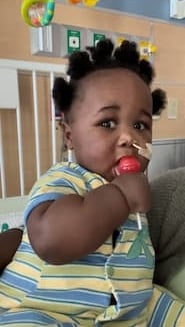
Cartier, Carti for short, has been a big smiler since the beginning. “He’s goofy, silly and adventurous,” says his dad, Quincy. But one morning when he was around 5 months old, Carti woke up without his spark.
“He’s a very happy baby,” said his mom, Rhajaé. “But that morning, he was not happy at all. He wasn’t eating; he wasn’t smiling.”
Then Carti started having trouble breathing. Two trips to an ER didn’t yield any answers. They had an appointment with their pediatrician the next morning, but family members encouraged them to drive from Lawrence, Kan., to Children’s Mercy Kansas City late that night. “Thank God we did,” said Rhajaé.
“They immediately went into action,” said Quincy. “Every nurse and doctor you can imagine was in the room trying to save Carti.”
A rare form of an uncommon condition
Carti was diagnosed with myocarditis. His care team in the Cardiac Intensive Care Unit (CICU), associated with the Ward Family Heart Center, put him on a ventilator and started him on medications to improve his heart function.
“Sometimes when the immune system is trying to clear a virus, it causes inflammation and the heart to not function well,” said David Sutcliffe, MD, Medical Director, Heart Transplantation and Ventricular Assist Device Services, Heart Center. “In Cartier’s case, it very severely decreased his heart’s squeezing, or ventricular, function.”
Myocarditis is relatively uncommon: Only 1 in 100,000 children are diagnosed, although many cases go undetected if symptoms are mild.
In about 60% of diagnosed myocarditis patients, the body can clear the infection and the heart recovers with careful medical management. Around 25% need ongoing cardiac care. And another 15% need more help, sometimes surgery.
Supported on ECMO
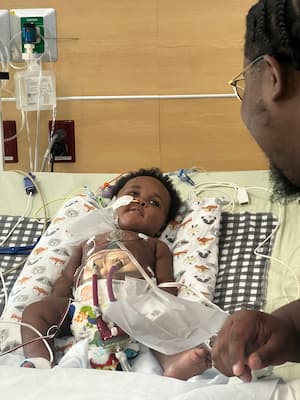
After six days with no improvement, Carti seemed to fall into that last category. His heart was still failing and having trouble getting blood to the rest of his little body.
“In order to keep his organs well-supported, we elected to put him on ECMO,” said Erica Molitor-Kirsch, MD, Medical Director, CICU.
Extracorporeal membrane oxygenation (ECMO), the most advanced form of life support available, would function as Carti’s heart and lungs while his care team determined their next steps. Quincy and Rhajaé commended the team for being proactive, including making sure Carti was in a bed location that made the transition to ECMO faster and easier.
The Children’s Mercy ECMO Program is platinum-designated by the Extracorporeal Life Support Organization (ELSO). The program serves around 50 patients per year (and well over 1,100 all-time) with a very experienced bedside team.
“We have team members who have seen it all watching out for these patients,” said Jenna Miller, MD, Pediatric ECMO Director. “They anticipate problems and act quickly to intervene. We are a center that people turn to for high-risk, high-complexity questions.”
VAD: a path forward
ECMO kept Carti stable while the team evaluated him for a Ventricular Assist Device (VAD) and heart transplant candidacy. A VAD connects the heart to a pump outside the body to help it function; Carti would need to stay in the hospital while on the VAD to wait for a donor heart.
“I remember asking Dr. Gibson [William Gibson, DO, Cardiothoracic Surgeon, Heart Center], ‘What is the likelihood that he's going to come off the VAD and not need a transplant?’” remembered Rhajaé. “And he said, ‘It’s not likely.’ We absolutely appreciate them giving it to us straight, but there was always a little hope in the back of our minds.”
After tests, studies and many family and team discussions, they decided to move forward with a VAD as a bridge to a transplant. They put Carti on the heart transplant waiting list.
“We want families to be active participants, and Rhajaé and Quincy have always been so engaged and actively involved in the decision-making,” said Dr. Sutcliffe. “You could just tell the depths of love they have for their son. They were able to manage that stress and the challenges so gracefully.”
In late July, Carti had open-heart surgery to implant the VAD.
Surprising improvement
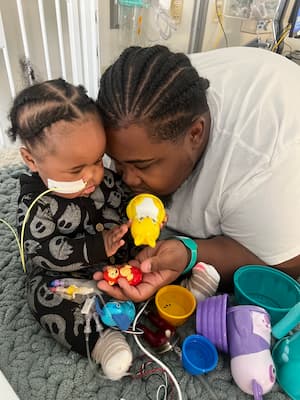
Rhajaé, Quincy and Carti settled into a routine in the CICU. They appreciated how their primary nurse, Kathryn Slagle, RN, BSN, cared for their family, including involving them in Carti’s daily care. “Kathryn said, ‘I’m going to show you how to do this, so you’ll have some connection,’” remembers Rhajaé. “You can’t hold him yet, but we can do this.”
“I feel like without Kathryn, Carti’s progress wouldn’t have been as fast as it was,” said Quincy, remembering that she would make sure Carti got to go on walks in the wagon and made them feel comfortable leaving if they had to run an errand. Slowly but surely, Carti improved.
“He started to gain weight really well, and therapy was working with him,” said Rhajaé. “He’s starting to get those muscles moving and gain his strength back, but it always came down to his heart.”
“The VAD gave stable support for his heart and let him get stronger,” said Dr. Sutcliffe. “We were continuing to look toward heart transplantation, but we started to note the squeezing function of his heart showed some improvement.”
This was an exciting — and rare — development.
“Once VADs go in, it’s often a one-way ticket toward transplantation,” said Dr. Sutcliffe. “Only about 5 to 11% of patients recover their squeezing function and can have their device removed.”
Carti’s heart size and function was starting to normalize. The big question was: Is Carti’s heart strong enough to work on its own?
Progress ... and setbacks
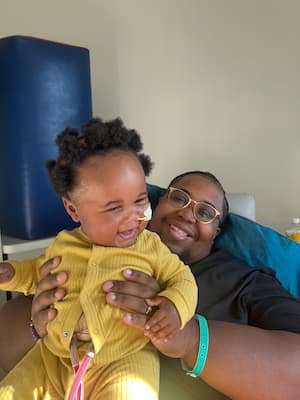
Carti improved so much that the family moved from the CICU to 4 Sutherland Tower, where non-intensive cardiac patients receive specialized care. Carti found a new champion in Alexandria Mowrey, RN, who coincidentally went to middle and high school with Quincy. “She’s probably why he’s so spoiled now,” laughed Quincy. “He loves being held.”
About two and a half months after receiving the VAD, Carti’s team prepared him for the process of weaning off it. Over five days, they turned the VAD off for longer periods of time to see how Carti’s heart tolerated the decreased support. The fifth day was spent in the Catheterization Lab, where physicians closely monitored Carti while the VAD was off for more than an hour.
It didn’t go well.
Carti’s heart wasn’t ready; he needed more time. He went back to full VAD support and remained on the active transplant list.
This disappointment was a turning point for Rhajaé. “One of the things friends in support groups said was, ‘I wish we didn’t rush the process; I wish we lived in the moment,’” said Rhajaé. So she recommitted to staying present and finding joy in every day. “Let’s make sure we’re still living. I gotta let go.”
They continued waiting and watching. Just when Carti seemed ready for weaning again, he caught rhinovirus. When he recovered, they tried again. This time Quincy and Rhajaé prepared themselves for another unsuccessful trial; they didn’t want to get too excited.
“I’ll never forget: We’re sitting in his room, and they came to tell us the results,” remembered Quincy. “I closed my eyes, and that was the only moment in my life where I didn’t have a single thought in my head.”
"He passed the test with flying colors,” said the Heart Failure team.
“When they said those words, I lost it,” Quincy laughed. “I cried so hard.”
Home and thriving
After four months with a VAD, Carti had surgery to remove it. One more setback was in store, though: The whole family got COVID the day after Carti’s operation. After a few more weeks of recovery for everyone, it was finally time to go home ... just in time for Christmas. “We pulled up to the Christmas tree, and it was straight into holiday mode!” said Rhajaé.
Now Carti is almost one and gaining ground fast. “We’re learning how to do baby things,” said Rhajaé. “He’s standing and learning how to eat. He’s moving and grooving.”
Their next goal is to work toward removing Carti’s G-tube. He has regular visits with the Heart Center now and will have cardiac follow-ups for years in the future to monitor his heart health.
“He is just the cutest, strongest baby,” said Dr. Sutcliffe. “He is thriving. We couldn’t be more excited for him and his family. It’s been such a privilege to have this journey with not only the family but with the multidisciplinary team in the Heart Center.”
“Two things stand out about this case: One is that it was a really remarkable story with an excellent recovery,” said Dr. Molitor-Kirsch. “And secondly, it is a great example of multidisciplinary collaboration. We are all extremely grateful to be part of the team that cared for Carti.”
Hundreds of team members contributed to Carti’s care, including those in the CICU, Cardiac Anesthesiology, Cardiac Surgery, the Heart Failure team, the ECMO team, physicians, advanced practice providers, nurses, social workers, child life specialists and innumerable support staff.
“The entire team dedicated to ongoing care for Carti (from nurse coordinators, to pharmacists, to Heart Failure doctors) remain hopeful and excited to see him grow,” said Dr. Sutcliffe.
“He’s a very, very strong kid,” said Quincy. “He’s gone through more than I’ve ever been through, and he made it look easy.”
"Rely on your village”
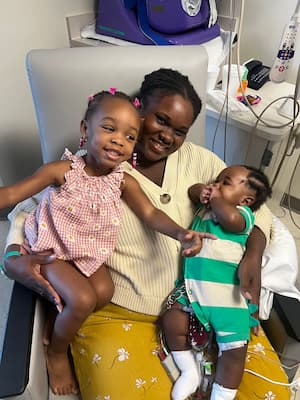
Carti’s squad extended far beyond his care team. In addition to their family and friends outside the hospital, Quincy and Rhajaé praised the support they got from three other families they became close with during their five months at Children’s Mercy. They were also grateful for how much attention team members gave to Carti’s big sister, Beau Willow.
Quincy’s advice for other families facing complex diagnoses and long hospital stays is to rely on your village and stay close to your faith. “If it’s a couple going through this process, depend on each other and stay patient with each other,” said Quincy. “At the end of the day, there’s only one goal: Get your child healthy and out of the hospital.”
“Make sure you still live your life,” agreed Rhajaé. “Children’s Mercy is amazing. They’re going to do everything in the interest of your child, and you’re going to come out on the other side. Just make sure you don’t waste all that time being scared.”
